
Holding it all together
By George Guidoni, Editor
Automation Converting Sustainability adhesives Adhesives and Sealants Council (ASC) Fabrication Sustainability hot-melt NordsonPackaging adhesives evolve in step with rising environmental and supply concerns
Being out of sight and out of mind is not the most glamorous way to earn keep in packaging or any other industry, but for manufacturers of packaging adhesives and adhesive applicating systems, such superficial behind-the-scenes anonymity has always been the ultimate end goal of superior performance and engineering.
While adhesives may often be the key ingredient of sound structural package design and effective product protection, any visible trace of adhesive leftovers or residue found on the surface of a finished package is naturally treated with scorn and contempt by customers and consumers alike as a sign of inferior packaging execution, and often rightfully so.
In this light, being invisible is a compliment of the highest order—and it takes a massive amount of top-level chemical engineering expertise and groundbreaking R&D (research-and-development) to make it happen just right for the end-use CPG (consumer packaged goods) manufacturers, the consumer public and, increasingly, the environment.
With packaging sustainability becoming a hot-button global issue in recent years, suppliers of packaging adhesive technologies are being increasingly challenged to hit the market with less toxic, more environmentally-friendly formulations for use by their demanding packaging and manufacturing customers, who are themselves relentlessly hounded by their retail customers about the environmental footprint of their products.
It’s a vicious but also a virtuous circle for a global industry estimated at US$40.9 billion in 2007—representing total world demand of 26 billion pounds—with North America accounting for a 30.1-percent share of that total, according to market researchers at DPNA International Inc.
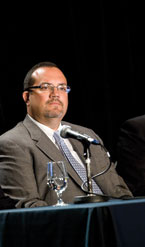
ASC president Matt Croson expects the North American adhesives market to grow annually by an average of 2.5 per cent in coming years.
And while the ongoing global economic slump has held back the overall market growth for adhesives and sealants over the last couple of years, Adhesives and Sealants Council (ASC) president Matt Croson says he expects the sector to grow ay average of 2.5 per cent in North America over the next three to five years, in large part as a result of increased focus on environmental and health-and-wellness issues throughout the global packaging supply chain.
“Sustainability and stricter customer requirements are certainly very strong market drivers for the industry these days,” Croson told Canadian Packaging magazine in a recent interview.
“This is especially becoming more pronounced in Canada, where industry is responding to concerted public and regulatory demands to improve the recyclability of PET (polyethylene terephthalate) bottles and thermoform packaging,” relates Croson, whose Bethesda, Md.-headquartered organization represents North America’s leading adhesives and sealants manufacturers.
Over the past summer months, Croson recounts, some ASC member-companies were involved in a joint industry research project—initiated by retail giants Walmart Canada and Loblaws—to improve the recyclability of collected bales of plastic packaging by ensuring all the adhesives used with those packaging substrates come off during the standard washing process to fully separate the individual plastic pieces—making them readily acceptable for the local recycling streams.
Right Response
“The adhesive suppliers responded with developing products that meet protocols established by NAPCOR National Association for PET Container Resources) and APR (Association of Postconsumer Plastic Recyclers) to ensure the adhesives efficiently wash off during the recycling process,” says Croson, saying such joint cross-sector efforts are becoming increasingly commonplace for adhesive suppliers and packaging end-users, who globally represent the second-biggest end-use market for adhesives and sealants after the construction sector.
“There are also other new customer requirements, such as the need for easy-to-open-and-reclose packaging formats, which are driving some serious product innovation for closure fitments at the package level—prompting adhesive companies to respond with innovative new ways to seal and reseal consumer packaging for the aging population,” Croson adds.
“That is always a goal: to work closely with customers, early and often, as they decide on new packaging,” explains Croson. “Keeping packaging properly sealed and protected, and adding the ability to easily open and close a product while maintaining good product protection, are critical engineering efforts that require a high-quality adhesive to ensure the seal is maintained through distribution and consumer use.
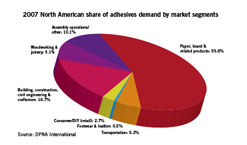 “Adhesives engineers are staying ahead of the curve in this area by working closely with design companies and end-user packaging teams to ensure those goals are being met,” says Croson, adding the tough economic times actually necessitate such cooperation to share the high financial R&D burden.
“Adhesives engineers are staying ahead of the curve in this area by working closely with design companies and end-user packaging teams to ensure those goals are being met,” says Croson, adding the tough economic times actually necessitate such cooperation to share the high financial R&D burden.
“The shaky economy is having an impact, and competition will remain tight in North America and the European Union,” Croson predicts. “In fact, we are expecting a slowdown as we head into 2012, but we don’t expect the market to recede as far as it did in 2009.
“But there is bright news for the entire sector as the growth in the use of adhesives and sealants in Asia is unprecedented and continues to grow,” Croson points out.
“We expect double-digit growth across all market segments in Asia in coming years, especially within China.”
Everchanging global market dynamics are nothing new to the German-headquartered consumer and industrial products group Henkel Corporation, whose Adhesive Technologies business sector accounts for approximately 45 per cent of the parent company’s worldwide revenues of about $22 billion.
According to Alexandria Symos, Henkel’s market development manager for packaging, consumer goods and construction adhesives in Bridgewater, N.J., the ongoing retail-driven shift to more sustainable packaging products is having a profound impact in redefining the adhesive suppliers’ business focus and strategies.
“Ten years ago the topic of sustainability certainly didn’t receive the attention it does today,” says Symos, but that has changed considerably since Walmart and other leading retailers began introducing packaging sustainability scorecard metrics to evaluate their vendors on the economic footprint of their packaged goods, along with rapid adoption of new packaging display concepts such as the much-lauded Retail Ready Packaging (RRP).
“Sustainability at the retail level is becoming really important for the adhesives industry,” says Symos, citing the RRP’s so-called 5 Easy’s requirements for easy identification, easy opening, easy shelving, easy disposing and easy shopping.
“These market dynamics touch many of our market segments, from carton- and case-sealing systems to folding-carton manufacturers, corrugated producers, and point-of-purchase display manufacturers,” she explains.
“Manufacturers are now increasingly reliant on the packaging to do the selling and create ‘shelf impact’ for the product,” Symos says, “so it’s critical for packagers to be using high-quality adhesives.
“Without them, the labels fall off, the cartons pop open [and] once this happens, it is no longer possible for the retailer to sell them, which can result in claims to the CPG manufacturer.”
Symos says that having a very diverse range of end-use clients enables Henkel to leverage the company’s vigorous R&D efforts in offering a comprehensive range of customizable solutions for its packaging customers.
Says Symos: “Henkel’s depth and breadth of products and technologies definitely creates advantage for packaging manufacturers around the globe with a full range in adhesives and coatings to meet the needs and end-use requirements of any packaging operation.
“The Henkel product line services all adhesive and coating needs of packagers and CPG manufacturers, spanning carton- and case-sealing, folding-carton and corrugated manufacturing and point-of-purchase display manufacture, along with offering a full line of specialty UV (ultraviolet) coatings that are formulated to increase shelf impact.
“We cater to every function—whether it’s a line operator trying to optimize the production line, or the brand manager looking for cost-effective ways to increase shelf impact, while improving sustainability scorecard marks for those products,” Symos relates.
“As a result, Henkel leverages the knowledge that exists in all areas of the global organization, making us the leader in innovation and sustainable solutions,” she expands. “All of our field teams are very market-focused, which allows for both product and application expertise—helping deliver operational optimization to our customers that brings value beyond the adhesive or coating.
“We now routinely collaborate with customers that have also built up competency in this discipline.”
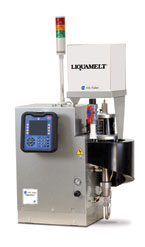
The new Liquamelt platform from H.B. Fuller is marketed as the packaging industry’s first low-density adhesive system capable of delivering a cool, sustainable, on-demand, liquid rapid-set adhesive for packaging applications, utilizing adhesives formulated with over 40-percent renewable bio-based content.

The new Liquamelt platform from H.B. Fuller is marketed as the packaging industry’s first low-density adhesive system capable of delivering a cool, sustainable, on-demand, liquid rapid-set adhesive for packaging applications, utilizing adhesives formulated with over 40-percent renewable bio-based content.
Bio Diversity
According to Symos, addressing packaging sustainability from the adhesives perspective inevitably requires further development of more bio-based formulations.
“There is a market necessity for developing sustainable solutions for sealing boxes and UV coatings, to replace foil stamping and foil board in terms achieving higher shelf impact,” says Symos, citing Henkel’s Mira Foil brand of UV coatings developed as an eco-friendlier alternative to foil board.
“Not only is it fully-recyclable through the whole deinking process, enabling an overall reduction in the carbon footprint and an improved scorecard performance,” she says, “its ‘foil-on-demand’ flexibility provides the customer with extensive lead-time and far less waste, while also ensuring effective shelf impact.”
In addition to carbon-footprint reduction, sustainability has also evolved as a pressing industry in terms of uncertain raw materials availability—oil in particular.
“The key ingredients for packaging hot-melt are derived from crude oil, and the growing competition from alternative markets for adhesives—such as the EVA films used in photovoltaic panels and athletic shoes markets, for example—is putting considerable strain on the supply of key raw materials,” Symos says, “resulting in volatility of stockfeed prices.
“Petrochemical-based raw material supply is a variable that had simply not existed to such a pronounced extent previously,” she states.
“Supply and demand of critical raw materials was far less of an issue only a few years ago, and the volatility of feedstock prices was also far less severe.”
David Petteplace, Canadian regional manager with adhesive applicating and dispensing systems supplier Nordson Canada, Limited in Markham, Ont., concurs.
“The most critical issue facing manufacturers and users of hot-melt adhesives is the ongoing shortage of raw materials necessary for their formulation,” Petteplace states. “The reduced petrochemical plant cracking capacity, feedstock shifts from liquid petroleum to natural gas, and competing demand driven by other industries and economies have created ongoing critical shortages.
“In addition, the growing demand for petrochemical-based products like tires, athletic shoes, packaged products and disposable hygiene products in emerging world economies places even more pressure on adhesive costs and availability,” he explains.
“So one of our current challenges is providing the market with innovative dispensing equipment and solutions that help packagers optimize every gram of adhesive,” says Petteplace.
For the Westlake, Ohio-headquartered parent Nordson Corporation, which designs, manufactures and markets a vast range of dispensing equipment for consumer and industrial adhesives, sealants and coatings at over 30 locations worldwide, that means being close to its far-flung customer base, according to Petteplace.
“Nordson recognized this deteriorating situation fairly early on—identifying and developing products and processes and partnering with adhesive companies packaging machinery OEMs to help packagers increase adhesive mileage and packages sealed per pound of adhesive,” he explains.
Petteplace relates: “The Nord brothers began focusing and conducting business globally in the 1960s, long before global sales were the norm, which is why we have long been recognized as the leader in adhesive dispensing technologies for the packaging, general assembly and disposable hygiene product manufacturing industries.
“As a global supplier to the packaging industry, we are constantly challenged to identify the new trends, opportunities, markets and niches,” he points out.
“Today, over 60 per cent of Nordson’s sales are generated outside of the U.S., as we continue to invest in emerging and growing markets in Asia, Latin America, Middle East and Eastern Europe—developing products that meet specific market, productivity, pricing and skill-level requirements.”
Global Bond
Petteplace says such globally dispersed growth strategy has enabled Nordson to practically standardize some of its patented product families as the packaging world’s de facto standard-bearers for adhesive applicating, citing the popular ProBlue range of adhesive melters renowned for their flexibility, configurability and remarkably low energy consumption—helping end-users achieve significant cost-savings on their production and packaging lines.
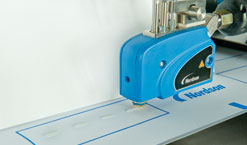
The new MiniBlue II adhesive applicator from Nordson Corporation employs Saturn Platinum solenoid valves to ensure service life of over 100 million cycles and two-millisecond cycle times.
“Our integrated adhesive melter/automated filling systems and retrofit automated filling systems are specifically designed to increase efficiency and productivity in packaging,” he says.
“Automated filling helps end all waste resulting from adhesive spilling, while delivering more consistent adhesive temperatures for better package bonding, and improving worker safety by eliminating repetitive lifting of the adhesives.”
Single Life
Petteplace points to the rapid consumer acceptance of single-serving convenience foods as one of the more notable recent consumer packaging trends impacting the ongoing technological evolution of new-generation delivery systems.
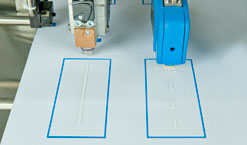
Nordson’s new OptiBond packaging solution typically employs two ultra-fast MiniBlue II pneumatic dispensing guns in a user-friendly configuration programmed to help end-users optimize their adhesive usage by up to 100 per cent, according to the company.
“This trend results in the use of more diverse packaging materials, which in their turn often require new adhesives and application technologies.”
Petteplace says Nordson takes great pride in being able to work with the world’s leading adhesives manufacturers to help speed up the commercialization of new-generation adhesives, especially the bio-based formulations.
“I am quite excited about the commercialization of some of the new adhesive formulations,” he reveals.
“Working with the major adhesive producers has enabled us to help them increase the acceptance of new adhesive formulations globally, such as the reactive adhesive materials for high-end clear-box and opaque plastic packages, as well as the lower-temperature metallocene adhesives used in rigid packaging.
“And the next evolution of bio-friendly raw materials and adhesives promises to be even more exciting for all of us in the industry.
“The speed of change in the packaging industry is much more rapid than it was 10 years ago,” he remarks. “Brand managers recognize that the consumer package aesthetics and functionality are an increasingly important part of the overall brand experience, and hence packages are changing more often with CPG companies looking to gain competitive advantage and market share.
“In turn, package designers continually seek out new materials, design concepts, and better ways to apply adhesives.”
While Petteplace says he understands the motivation of some CPG brand-owners to squeeze out packaging costs wherever possible to stay in the good graces of their retail customers, he asserts that cutting corners by substituting high-quality adhesives with lower-cost formulations is a self-defeating fallacy.
“Any CPG manufacturers seeking improved profitability should really avoid trying to economize by using lower-quality, less expensive adhesives,” he cautions.
“Using high-quality adhesives plays a key role in enabling the success of new package designs, new packaging techniques and new packaging materials,” he says, “and poor bonding or sealing will dramatically negate the package’s performance, shelf appeal and brand perception.
“In addition to better bonding and sealing, quality adhesives typically create less charring—resulting in fewer reject packages, less package rework, less frequent adhesive dispensing equipment part replacement, and less maintenance and downtime.”
Upbeat View
Despite price volatility and supply uncertainties, Petteplace says he’s cautiously positive about near-term prospects for the global adhesives business.
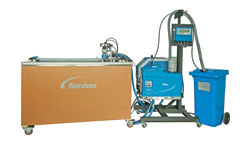
Displayed at the recent PACK EXPO Las Vegas 2011 packaging technologies exhibition, Nordson’s Fulfill applicating system is shown here feeding the company’s ProBlue and AltaBlue melters supplying packaging adhesives to the MiniBlue II and SureBread dispensing guns.
“We are very encouraged with the resilience and buoyancy of the packaging industry despite all the global economic uncertainty,” he responds, “and we will continue to develop technologies that meet the changing landscape of substrates, adhesives, new packages and branding needs.
“Our focus will always be to help CPG companies maximize their productivity, efficiency and product quality, while providing our packaging customers with faster, more flexible and configurable equipment with increased reliability, safety and usability,” Petteplace states.
“We are all facing the same challenges in the adhesives market,” asserts John Channon, North American packaging adhesives director for H.B. Fuller Company in St. Paul, Minn. “Our customers want to do more with less and raw materials are extremely volatile—driven by supply constraints and increasing input costs.
“Sustainability, security (package integrity), demographics and increasing input costs are key trends in the packaging industry right now, and the packaging industry is constantly challenged with creating an instant connection with their customers in a fraction of a second while the product is on display.
“So as a result, reduction of input and process costs continues to be a significant trend, perhaps becoming more intensified as the markets have become more global in scope,” Channon elaborates.
“So it is our job, as one of North America’s largest adhesives suppliers, to provide our customers in the packaging industry with high-performance, innovative adhesive solutions that will help them overcome those challenges and improve their products and processes.”
Says Channon: “The trends impacting our industry have driven the development of high-performance adhesive systems that enable processing of more complex package configurations, more sophisticated substrate design and varied combinations of such, as well as continued improvements in speed and productivity.
“This allows our customers to improve the productivity of their processes without adding capacity,”
he notes.
“Clean-running, high-performance adhesives also enable package consistency and integrity, standardization across customers’ networks and applications, and more uptime with fewer maintenance needs.”
Hot Stuff
Channon says H.B. Fuller practically invented the entire category of high-performance hotmelt packaging adhesives with its 1997 launch of the Advantra hotmelt product line—since used to secure over 100 billion cases of shipped product—recently been expanded with the new-generation Advantra Encore technology.
“This proprietary packaging adhesive technology platform provides for better bonding, higher mileage and a broader service temperature range than traditional metallocene-based and EVA hot-melt technologies,” he states.
“Along with our new Liquamelt adhesive platform, it also offers our customers unique alternatives that provide environmental benefits such as lower energy and adhesive consumption and less waste, and are more readily available to the packaging market than traditional hotmelt technologies.
“We are deeply committed to answering the challenges facing the packaging industry with innovation by providing tangible solutions to address our customers’ unique challenges.”
For example, the company’s new lines of Flextra Fast and Flextra Quiet adhesives were developed specifically for flexible packaging customers to enable them to achieve faster processing times working with bio-based packaging films, Channon explains, with the latter formulated specifically to dampen the noise generated by the handling of flexible packaging made from bioplastic constructions—such as the notorious, noisemaking SunChips bags of potato chips introduced last year by PepsiCo.
Says Channon: “The adhesives industry basically holds the world together, and as a result we really believe that the future is bright for both our company and the industry in general.
“A box is just a box—it is the adhesive that actually makes it a packaging container,” Channon points out.
“And as the world’s strong demand for more sustainable packaging solutions continues to grow,” he concludes, “the adhesives industry will remain the perfect source for further innovations to enable leading CPGs to achieve their sustainability goals.”
Advertisement

